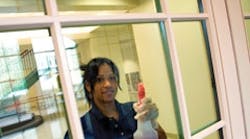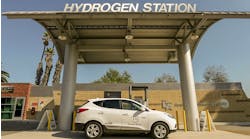Program Information
Number of students: 15,492
Square footage maintained: 2,878,207
Number of full-time custodians: 69
Annual cleaning budget: $3,491,600
Green cleaning team members: Velda Robins, Building Services Manager; Rick Byrd, Head Custodian; Rosie Booze, Ashraf Al Shawabkeh, Paul Huston, Daniel McCormick, Supervisors; ISS (Hard Surfaces and Carpet Floors), Cleaning Contractor; Rochester Midland, Janitorial Product Distributor
In 2007, the University of Missouri Kansas City (UMKC) Campus Facilities Building Services unit made the commitment to participate in green cleaning strategies. From the custodian on the floor to students, faculty and staff in the buildings, green cleaning has been embraced as the gold standard. There are currently 43 buildings being cleaned as a part of the campus green cleaning program. The benefits of the program are many; however, the focus of the program is to reduce the use of hazardous chemicals with safer, environmentally friendly cleaning products, improve indoor air quality, reduce the risk of employee contamination which could result in accidents from a safety perspective and implement a set standard for best practices in the workplace through interactive education of all employees.
Prior to the program, UMKC’s custodians used toxic chemicals in their everyday workplace. These chemicals were not only toxic for the workers, but also had dangerous health, reactive and sometime flammable components. Since the implementation of the green cleaning program, hundreds of toxic chemicals have been eliminated from use on campus and have been replaced with just three daily cleaners with environmentally friendly ingredients. For the last two years, custodians have been using microfiber towels and flat mops to clean all areas within the facilities. The microfiber towels have taken the place of the disposable cleaning towels, and the flat mops are used instead of string mops and buckets. A touch-free system used to clean restrooms also conserves water and reduces the amount of cleaning supplies necessary to sanitize those areas. In a pilot program, stainless steel in elevators and other public areas are being cleaned using a product that takes advantage of electrically charged water instead of chemicals.
Procedures/Strategies
The sustainable strategy of the green cleaning program is to minimize the amount of risk to the custodians and the individuals served while balancing the long-term economic and environmental benefits. The triple bottom line is a critical component when evaluating any program, especially with programs where consumable product lines are continuing to raise the costs of doing business. The Certified Green Housekeeping Program is focused on intensive initial and ongoing training and certification that include partnerships with Roesel, Kent and Associates OJT interactive electronic program, Rochester Midland’s Enviro Care and the campus and the local OSHA (Occupational Safety and Health Association). The training includes the use of green cleaning products, equipment and tools properly; how- to techniques to reduce cross-contamination of surfaces; procedures for universal hazardous-waste handling; bloodborne pathogens; and inventory-control measures. Programs focused on disinfection are designed to reduce student, faculty and staff exposure to harmful diseases or contaminants.
Other educational training includes quarterly hands-on training given by supervisory staff at their zone meetings that stress safety training; building liaison meetings with staff to ensure that they know the cleaning plan for their buildings; and visible Safety Notebooks with MSDS information and contact number for the building services management team. Each building has a program for floor-by-floor chemical and equipment inventory, routine cleaning assignments per staff member, training cards for floor assignments, supervisory cleaning task checks and cost projections by facility. There are also checklists filled out by each custodian and the supervisors are turned in for a final building report.
Policies for Green Cleaning
Using green products have become a mandatory practice for Building Services at UMKC. There is more awareness of the hazards and threats associated with regular cleaning methods pertaining to toxins chemicals and safety hazards to staff. All custodial assignments are calculated for seven hours per day. The assignments are placed on the custodial carts in each zone for easy access and to refer to as needed. Cleaning specifications are scheduled to service public spaces daily and private spaces, which are office areas and research labs, once a week. There is one office cleaner per zone that cleans all the offices in each zone.
Interactive Training
The custodians and supervisors are required to attend a two-day interactive training session and then an eight- day hands-on and academic training session prior to beginning their permanent assignment. The Green Housekeeper Program Certification program is an established, consistent method of standardized work methods based on green cleaning practices, worker safety training, customer service and is a requirement for eligible employees to advance in Building Service positions. To date, nearly 275 employees and supervisors have completed the training. Building Services operates on the basis of best business practices in all its operations.
Innovations
- Certified Green Housekeeping Program is a program where shared responsibility and consistency is focused upon along with the use of green cleaners, methods for cleaning with water, along with safety and health education.
-Green Seal listserv (educational), ISSA, the Worldwide Cleaning Industry Association and a UMKC Sustainability Buildings website at ( http://info.umkc.edu/sustainability/green-campus/buildings/) were developed to provide information to the campus community.
- Waste Wise Program by EPA R 7.
- Design for the Environment (DFE) educational series on cleaning alternatives at home and in the workplace.
Evaluation
The impact of this comprehensive process improvement has been substantial, resulting in:
•Decrease in the number of serious employee injuries from slips/falls (462 lost hours in 2007 to 80 lost hours Jan-Aug 2011).
•A decrease in the number of individual complaints about poor air quality and associated asthma and other respiratory events.
•Awarding of certificates to nearly 125 employees who have completed the standardized training offered through the Green Housekeeping Program Certification.
•Building Services has worked with campus procurement office staff to get a dozen green cleaning items offered by vendors and that number is growing weekly.
•Building Services has seen cost savings from $300, 000 spent on traditional cleaners in 2008 to $140,000 in 2011 for the three green daily cleaners and Green Seal-certified hand soap.
Policies or processes
The policy of Building Services is “Our commitment to sustainable practices is threefold. We invest in the future by being committed to protect the environment, campus resources and campus and local communities through best practices. Green cleaning is a large part of this commitment.”
Orientation Presentation includes green cleaning:
-Use of Hillyard GS-42 Green Manual*
-Use of training toolkit modals from http://www.cleaningforhealthyschools.org/
Communications/Community engagement
-Work in partnerships with campus student group to publicize green cleaning; campuswide recycling efforts; Environmental Studies Student Association; and faculty/staff group to publicize green cleaning and sustainability efforts via the UMKC Sustainability Team.
-Visible presence on the UMKC Sustainability website: http://info.umkc.edu/sustainability/green-campus/buildings/
-Presentations at other local schools, universities on the green cleaning program.
-Presentations at community events with the KC Chamber of Commerce, Green Fest, Earth Day, USGBC, etc.
Recognition
-Environmental Excellence Award by Bridging The Gap, Inc.
-Sierra Club Cool School 100 Top Universities
-Awarded ‘Best Program’ by Mid America Regional Council-Solid Waste Management District
-Featured in Greenability Magazine as the ‘greenest’ regional university



